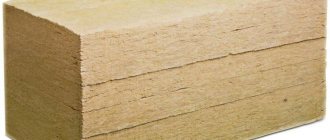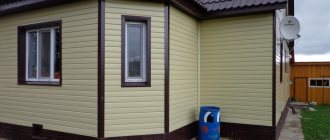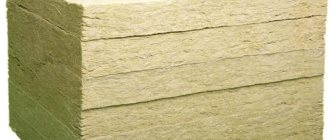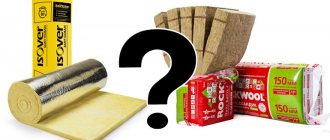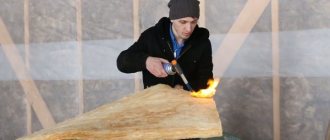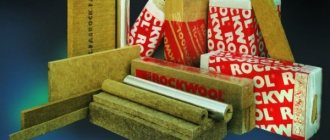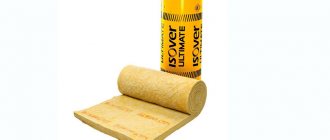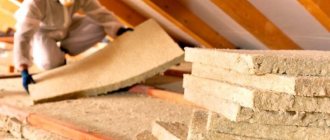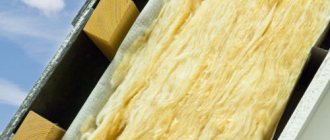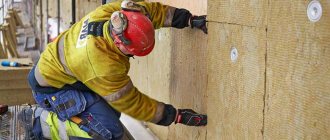Photo: Options for basalt wool. Author: Maxim Divanov Basalt or stone wool is one of the best insulation and soundproofing materials. Today the market offers a huge selection of materials with similar properties and qualities. Ecowool, glass fiber, slag wool - all these materials are similar to each other, but have different characteristics and are suitable for certain conditions of use. To understand what kind of wool is used for what, it is necessary to take a closer look at the composition, characteristics and features of the materials. It is these questions that we will try to consider in this material.
Kinds
Depending on the composition, properties and scope of application, there are 3 main types of wool for sound insulation:
Material
Basalt
The material is based on basalt, which is durable. This determines the best sound and thermal insulation of the finished product, the ability to withstand heating while maintaining technical properties up to a temperature of +600 degrees.
To make basalt wool, fibers 16 mm long are used. Their diameter does not exceed 12 microns. Unlike slag and glass, this type of mineral wool is environmentally safe, it is convenient to cut, and it does not prick when used during the installation process.
Glass
Glass wool is a product of glass and limestone processing, to which sand and soda are added. The result is a strong and elastic material, which, however, has less fire resistance. The maximum heating temperature is 500 degrees. The material is very fragile and itchy. Release form: rolls.
Slag
The basis of the material is blast furnace slag, which is characterized by residual acidity. In this regard, even a small amount of water that gets on the insulation, provided that it is laid on top of metal, provokes the emergence of an aggressive environment.
Characterized by increased hygroscopicity, slag wool is not used for insulating facades and pipelines. The maximum possible heating of the material does not exceed 300 degrees.
Ecowool
It is a material consisting of 80% recycled cellulose. Initially, ecowool was used to insulate the building, but they quickly discovered that it was also suitable for sound insulation. In terms of its thermal insulation properties, it is not inferior to foam plastic, however, rigid polystyrene boards are not suitable for insulating pipes and other structures of complex shape.
Density
Depending on the density indicators, the following types of wool are distinguished:
Lightweight
Density indicators – up to 90 kg/m³. Serves for heat and sound insulation, mounted in places not subject to loads. An example of this type of material is soundproofing mineral wool P-75 with a density of 75 kg/m³. It is suitable for thermal insulation and sound insulation of attics and roofs, heating network pipelines, gas pipelines.
Tough
It is characterized by a density of more than 90 kg/m³; during use it may be subject to some load (its degree is determined by the density of the wool). Hard wool includes P-125 wool, used for insulating walls and ceilings of buildings and internal partitions of premises.
Technical
It is used for insulating industrial equipment and can withstand significant loads. For example, PPZh-200 mineral wool is used for insulating engineering structures and serves to increase the fire resistance of structures.
Release form
Depending on the form of release, mineral wool products are of the following types.
Mats
Convenient for use over a large area for installation in suspended ceilings and partitions. For ease of transportation and storage, the material is produced in compressed form, and after opening the packaging it acquires the declared parameters. The disadvantage is the difficulty of cutting into small pieces.
Plates
Tile products have good sound insulation properties (especially when absorbing “airborne” noise) and are easy to install. It is used to insulate roof slopes, walls, and ceilings. Density indicators usually do not exceed 30 kg/m³
Rigid slabs
This material in slabs is recommended for absorbing “impact” noise. They are easy to install and easy to cut
An important requirement is to lay a vapor barrier layer between the insulating material and the ceiling
Rolls
Material of small and medium hardness is usually rolled into rolls. Thanks to this shape, it is convenient and easy to transport; the user has the opportunity to cut layers of material to the desired length. The width of the material is standard and is usually 1 m.
Finally, there is acoustic wool that has a foil layer on one side. Sound insulation using foil material is effective, but is suitable for external parts of buildings or with careful insulation of the material with film.
Material with foil does not require additional waterproofing; in addition, its thermal insulation properties are increased due to the ability to reflect thermal radiation.
The production form of foil insulator is rolls and slabs of basalt wool or fiberglass with foil applied to one side. The thickness of the material is 5-10 cm.
Pros and cons of basalt wool
Photo: Stone wool.
Author: Maxim Divanov Basalt wool is considered a popular material, as it has many advantages compared to mineral insulation. The advantages of basalt wool include:
- High rate of sound and thermal insulation. If we compare the material with mineral analogues, the difference can reach half. Due to this quality, wool is used in the construction industry as the main element of sound insulation.
- Absolute fire safety. Basalt material is not subject to combustion, melting and the release of toxic fumes. It is for this reason that such insulation is used for residential premises of houses and apartments. The production of basalt wool is carried out at temperatures above a thousand degrees Celsius, so the fire-resistant characteristics of the material are very high.
- Strength of the material. Compared to other insulation materials, basalt slabs are quite strong and are not subject to mechanical stress or deformation. Due to the strength of the material, it is used for facade insulation of walls. The installed basalt slabs are reinforced and plastered, resulting in not only a reliable, but also an attractive finish. Cotton wool protects walls from the cold no worse than foam plastic, while air passes through it and the walls breathe. Due to these qualities, the popularity of basalt insulation is constantly increasing.
- Performance. The material does not rot even when used in an aggressive environment. Basalt thermal insulation will last for many years without losing its quality and thermal insulation properties.
- Easy to install. Unlike other materials, basalt wool is easy to install. Given the light weight of the material, even one person can handle it. Independent insulation of walls using basalt material will not only improve the characteristics of the walls, but also save on calling specialists.
Photo: Stone wool layers.
Author: Maxim Divanov As for the disadvantages, the material has very few of them, and the main one is fragility. If you bend a basalt slab, it breaks, so you need to be careful when transporting and installing it.
What are acoustic mineral wool mats
The production technology of acoustic mineral wool boards has some differences from the production technology of heat-insulating mats. For example, sound insulation with Amigran acoustic mineral wool demonstrates a remarkable effect, since this material is made from special granulated hydrophobized mineral wool and a binder - starch.
The material obtained in this way has a density of 300 to 400 kg/m3 with a sound absorption coefficient of 0.7-0.9.
Soundproofing mineral wool "Akminit" is manufactured using a more complex, semi-wet technology, which significantly increases its performance indicators, such as strength and resistance to deformation.
Acoustic mineral wool for sound insulation from Finnish and “Acousto-Melody”) are also manufactured using “wet” technology with vacuum, similar to the technology for manufacturing fiberboard boards.
This technology allows for maximum sound and noise insulation, long service life and fire safety.
Soundproofing mineral wool "Shumanet BM" is considered one of the most effective building materials in this regard. This is ensured by the excellent acoustic and consumer characteristics of Shumanet BM.
This material is widely used as a special layer in the construction of frame partitions, wall cladding with sheet plasterboard, chipboard, for suspended ceilings and acoustic screens.
The sound-absorbing board Shumanet BM, made of mineral wool, is considered the most effective building material for heat and sound insulation.
This type of mineral wool is widely used as a special layer when creating frame soundproofing partitions, when facing walls with sheets of plasterboard, chipboard, for suspended ceilings or acoustic perforated screens.
Sound insulation: polystyrene foam or mineral wool?
Myth one. Polystyrene foam is an excellent soundproofing and sound-absorbing insulation material. As you know, polystyrene foam is produced and sold in sheets of various thicknesses and densities. Different manufacturers call their product differently, but, nevertheless, it is all polystyrene foam (expanded polystyrene).
Polystyrene foam is a wonderful heat insulator that has nothing to do with sound and sound insulation. The only structure where it can affect noise is when laying a so-called “floating” floor under a screed. Yes, and this only applies to “impact” noise.
At the same time, the effectiveness of a layer of expanded polystyrene 40-50 mm does not exceed the effectiveness of other types of sound insulators with a thickness of only 3-5 mm.
Myth two. The use of mineral or glass wool slabs in frame construction is more than enough to ensure a high level of sound and noise insulation between adjacent rooms.
Indeed, special acoustic mats made from acoustic mineral wool will provide sound insulation of frame partitions by 5 to 8 decibels. The use of arbitrary insulation will lead to much less efficiency, or will not have a sound-reducing effect at all.
Thus, when choosing mineral wool as a sound and noise insulator, you are making the absolutely right choice. However, acoustic mineral wool should not be used just like that, but in combination with special “acoustic” enclosing structures and special “acoustic” fastenings.
Application of basalt wool
As mentioned earlier, basalt wool has a fairly wide range of applications. It is used for insulation of house facades and internal insulation for its characteristics and qualities. A house insulated with this material will keep it warm in winter and cool on a hot summer day.
Basalt slabs are also used as sound and noise insulation. The material perfectly absorbs airborne and vibration sounds due to its soft fibrous structure. Using this insulation, thermal insulation of pipelines for various purposes is carried out. If a pipeline is insulated, the material used is a cylindrical slab consisting of two halves.
Types of mineral wool
Based on the raw materials used for the production of mineral wool, finished insulation materials are divided into three types:
Glass wool
To obtain glass wool, broken glass or waste from glass production is usually used. Additionally, dolomite, sand, soda and other substances are added to this mass. Thanks to this composition, glass wool is highly resistant to various chemical reactions and can be used not only for insulation, but also as a protectant against certain chemical components.
The length of glass wool fibers ranges from 15 to 50 mm, while their thickness is only about 10 microns. The density of this type of mineral wool is 130 grams per cubic meter. As for the heating temperature, glass wool can withstand up to 450 °C. This is a decent indicator of fire resistance, allowing the use of this type of material in fire hazardous areas.
Stone wool
It is made on the same principle as glass wool, but different raw materials are used for its production. Most often this is waste from the extraction of natural rock stone. Basalt rocks and gabbro granite are especially popular.
The thickness of its fibers can be from 4 to 12 microns, and the length is no more than 15 mm. Thus, stone wool is stronger than glass wool - this is due to its structure and the source material from which it is made. However, its resistance to heat is much lower. Stone wool can withstand heating temperatures of no more than 300 °C. This nuance must be taken into account when choosing insulation material.
Slag wool
It is made from blast furnace waste, that is, various types of slag dumps - as its name suggests. Its structure is identical to stone wool - it has the same fiber size. But as for fire-resistant qualities, slag wool is the most resistant to heat and can easily withstand temperatures up to 600 °C.
FAQ
When choosing insulation for a home, the question often arises of how safe basalt wool is. Taking into account the specifics of production, the material is made from environmentally friendly raw materials and cannot negatively affect human health and well-being. It is also worth noting the fact that basalt wool is a non-flammable material, so it also protects the room from fire.
Photo: Basalt wool. Author: Maxim Divanov
People are also often interested in what criteria should be used to choose insulation for walls in an apartment. It is worth understanding that the thicker the material, the higher its thermal insulation qualities, however, too much thickness will reduce the area of the room. The optimal slab thickness for walls in an apartment is considered to be five centimeters. This thickness will be enough to retain heat and limit the penetration of extraneous sounds.
Basalt wool or ecowool
Basalt or stone wool has some similarities with ecowool. The thermal insulation qualities of one and the second insulation depend on the density of the product. Basalt wool is made from rock, which makes the material completely non-flammable. In the case of ecowool, it is considered a product of recycling paper waste. Fillers are added to processed raw materials to prevent rotting and burning. The structure of the basalt slab has a solid base and can be installed under various conditions. As for ecowool, it is free-flowing, so a certain system is required during installation, so making thermal insulation yourself will be problematic.
Basalt wool or mineral wool
All materials have both pros and cons. To figure out which is better, you need to consider the characteristics of the materials. Basalt wool is made from rock by melting. In terms of thermal insulation properties, basalt wool is better, since the structure of the materials has a significant difference in the number of fibers and loose structure. Of course, it’s impossible to say for sure that basalt wool is better, but according to some criteria it is still superior to mineral wool.
Criteria for selecting soundproofing materials
Before buying a soundproofer, you need to consider the following factors:
- purpose of the room. Materials intended for living rooms should not be used in the bathroom or kitchen. For them, it is advisable to purchase materials that are resistant to temperature changes and moisture;
- room dimensions. If the room is large, you can use a thick multilayer insulator, which is mounted using a frame (for example, mineral wool). If the room is small, then ultra-thin soundproofing materials that practically do not “eat up” the space are preferable;
- texture, quality. The price of a sound absorber directly depends on these factors. You should take a particularly responsible approach to the decoration of residential premises. The insulator must not contain toxic substances that can harm health;
- integrity of the coating. If the material is mounted with slabs, sealing of the joints is necessary. Otherwise, it is unlikely that it will be possible to achieve good sound insulation;
- price category. The desire to save money is quite understandable. However, it is necessary to take into account not only the cost as such, but also the rationality of expenditure and the volume of waste. Only in this case will the purchase be truly profitable. In addition, you should not buy a frankly cheap insulator: dumping price and good quality are different planets;
- environmental Safety. Panels made of synthetic soundproofing materials have excellent soundproofing, but can cause allergies. As for natural materials, such as cork or basalt, they are considered the most environmentally friendly.
General characteristics
What other characteristics make mineral wool a popular and widely used material? Today the following qualities are especially valuable:
- the low amount of phenol-formaldehyde mixtures in the composition makes the material suitable for indoor use;
- mineral wool is not of interest to rodents and is not a favorable biological environment for mold growth;
- the material is characterized by increased resistance to environmental temperature fluctuations. Stone mineral wool is capable of maintaining its basic characteristics for 50 years; other types last a little less;
- thanks to porosity, vapor permeability is ensured, which is necessary for normal air exchange and good sound insulation;
- mineral insulation is a fire-resistant material that is incapable of spontaneous combustion;
- does not react with various chemicals;
- the elasticity of mineral wool and slight shrinkage after installation ensures thermal insulation properties for a long time;
- has low thermal conductivity coefficients, due to which it provides a good level of thermal insulation;
- Mineral wool insulation is easily cut into pieces and easily installed; some types of slabs are produced with joint grooves.
How much does mineral wool cost at the moment? The range of prices varies significantly, but one thing can be said with confidence: the higher the technical characteristics of mineral wool, the denser and stiffer the material, the more expensive it is. The cheapest options are soft mineral wool in rolls made from slag and glass, the most expensive are stone wool slabs with maximum density. True, a house insulated with such material will stand almost forever.
Specifications
Basalt wool, also known as stone mineral wool, is a fairly popular type of material that is used in modern construction. Due to its characteristics and features, it is used for heat and sound insulation of apartments, houses and technical premises. In addition to the insulating qualities of basalt wool, it has non-flammable properties. The material is absolutely not subject to burning or melting. When exposed to high temperatures, smoke and harmful substances are not released. Due to its non-flammable properties, basalt wool is used as insulation in residential buildings and public buildings.
Technical characteristics of basalt wool
Basalt wool is an effective sound insulator. The soft structure of the material allows it to absorb up to 45 dB of sound waves. This material is used for frame and frameless sound insulation. Basalt wool slabs can also be used for exterior wall decoration, since the fibrous structure allows air to pass through well. Mold and mildew do not form between the surface of the wall and the insulation. In addition, the structure of basalt slabs has good water-repellent characteristics, which allows the material to be used for exterior wall decoration.
Manufacturers of basalt wool offer customers material of various sizes and densities, which allows you to select the insulation for various purposes as accurately as possible. The only thing that is important to consider when choosing a quality material is that you should buy it only from a proven and reliable supplier who meets all production requirements. Before reaching the consumer, basalt wool undergoes all kinds of testing and inspections so that the buyer can purchase a high-quality product.
Basalt mats: characteristics of the sound absorption coefficient of BZM mats
Sound absorption coefficients
Basalt sound-absorbing mats or (BZM) are used to provide sound insulation in rooms and equipment. The mat consists of ultra-thin basalt fibers and a fabric base. The base can be glass, basalt or silica fabrics.
The BZM is marked, where the last letter indicates the fabric base used in the mat.
- BZM_S glass fabric;
- BZM_B basalt fabric;
- BZM_K silica fabric.
The difference between the mats is also in the maximum temperature conditions. BZM are used in various fields of industry and construction. The heat and sound insulation qualities of the material become indispensable for pipelines, gas turbine units, ventilation systems, etc.
Features of material selection
Among the numerous manufacturers of mineral wool, the most popular are the following brands: TechnoNIKOL, Ursa, Rockwool, Knauf and Izover. The cost of the material depends directly on its density, because the higher this parameter, the more raw materials are required during production. Although on average the cost ranges from 100-180 rubles per square meter.
Before purchasing, you must carefully examine the packaging in order to find out whether GOST requirements were taken into account during manufacturing. Also read the characteristics, ask the seller to open one package.
Find out where the fibers are directed in the material. If they are vertical, then the mineral wool will perfectly retain thermal energy, but if in a chaotic manner, then the insulation is very durable and, accordingly, can withstand heavy loads. Glass wool and slag wool are cheaper, but you should think twice before purchasing them. Despite the fact that the thermal insulation of these materials is increased, quite a few difficulties arise during their installation. Thus, glass wool, if it gets on the skin or in the eyes, can lead to serious irritation.
Classification of mineral wool by type
Depending on the needs and purpose, it is necessary to pay attention not only to the thickness and dimensions of the material, but also to its properties. According to GOST 52953-2008, mineral wool comes in several types, which are classified as:
- fiberglass (glass wool);
- slag fiber (slag wool);
- stone fiber (stone wool).
Each type of mineral wool differs in the thickness and length of the fibers, has a different level of resistance to stress, coefficient of thermal conductivity, moisture resistance and resistance to heat (high temperature)
At the same time, in particular, working with glass wool causes certain difficulties and inconveniences; it should be used while observing safety precautions
Therefore, when choosing, it is very important to pay attention to each of these parameters and purchase the type of mineral wool that is most suitable for the work being performed. You can find out more about the characteristics of each type below.
Fiberglass
This type of material is very strong and elastic precisely due to the size of the fibers, the thickness of which is 5-15 microns, length - 15-50 mm. In addition to its good thermal insulation characteristics, glass wool has significant disadvantages. Various pests (rodents, insects, etc.) get along well in it. And also, when laying it, there is a danger to human health.
It is necessary to work with it extremely carefully, wearing gloves, goggles and a respirator. Glass fibers can penetrate the skin, get into the eyes and lungs, thereby injuring organs. Technical characteristics of fiberglass:
Fiberglass Specifications:
- fiber thickness - 5-15 microns;
- fiber length - 15-50 mm;
- coefficient thermal conductivity – 0.03-0.052 Watt/m/Kelvin;
- max heating temperature – 500 C;
- max cooling t – (-)60 C.
Slag fiber
Industrial waste – blast furnace slag – is used to produce slag wool. When insulating a room, it should be remembered that they have high residual acidity, so condensation, dampness and moisture in the room will contribute to the negative impact of slag on the metal surface and structures.
The properties of such heat-insulating fiber include significant absorption of moisture; therefore, it is not recommended to use it for cladding the facades of construction sites and water pipes. It has increased fragility and is sharp to the touch, so it is necessary to work with it with gloves.
Technical characteristics of slag fiber:
- fiber thickness - 4-12 microns;
- fiber length - 16 mm;
- coefficient thermal conductivity in a dry state – 0.46-0.48 Watt/m/Kelvin;
- max heating temperature – 300 C;
- hygroscopicity index is high.
Stone (basalt) wool
Thanks to its heat-insulating, moisture-resistant, sound-proofing and other properties, this type of mineral wool is the leader among all the insulating materials presented. Often, the name mineral wool refers to stone wool. For its production, rocks of volcanic origin are used - diabase or gabbro. After placing these rocks in the furnace, increased pressure is created, the material heats up and begins to melt, after which cotton fibers and various binding components are added to it.
Stone wool is highly resistant to a number of mechanical and vibration loads; when heated above the permissible limit, the material does not burn. It differs from slag and fiberglass in the greatest safety during operation. The size of its fibers is similar to slag wool fibers, but they do not prick and do not injure the skin.
Basalt wool is also a type of stone fiberglass. Unlike stone, it is distinguished by the absence of impurities. No charge, blast furnace slag, clay, limestone rocks and dolomite are added to it, the amount of which can sometimes be up to 35% of the total volume of the substance. Basalt wool does not contain additional mineral binding components, such as formaldehyde resin, which, when evaporated, is hazardous to humans.
Technical characteristics of stone fiber:
- fiber thickness - 4-12 microns;
- fiber length - 16 mm;
- coefficient thermal conductivity – 0.041-0.045 Watt/m/Kelvin;
- max heating temperature – 1000 C;
- max cooling t – (-)190 C.
Features of floor soundproofing
Sound insulation of the floor base is carried out using two methods - using the “floating floor” technology or using wooden joists. The first option involves laying an elastic soundproofing material between the screed and the finishing coating, which absorbs extraneous sounds and impacts. The optimal solution for implementing sound insulation in an apartment is ISOVER mineral wool slabs based on quartz, which are characterized by increased elasticity and, as part of the system, provide sound insulation from impact noise up to 35-37 dB.
Laying mineral wool on wooden logs is carried out with the construction of a frame. The bars are placed at a distance of 600 mm from each other and secured to the floor through a damper tape. Mineral wool is placed in the cavities between the joists without additional fixation. When cutting along the edges of the material, it is necessary to leave allowances of 10–20 mm, which will ensure a tighter fit to the frame. The top of the slabs is covered with OSB or moisture-resistant plywood, sealing the joints and the perimeter of the junction with the walls with sealant, and then finishing is carried out.
As you can see, mineral wool is a universal soundproofing (sound-absorbing) material for walls, ceilings and floors. With its help, you can effectively soundproof rooms and ensure comfortable living without paying attention to extraneous noise.
Release form
Soundproofing mineral wool is available in the following forms:
- swearing;
- soft, hard slabs;
- rolls
Mats
The form is suitable for use in insulating suspended ceilings, walls, and partitions. To make the material convenient to transport, it is produced in compressed form in special packaging. After opening it, the mat expands to the stated size. If the task at hand requires working with small-sized parts, then mats will not be suitable. They are difficult to cut.
Plates
The slabs have excellent sound insulation properties. This form is widely used in working with roofs, walls, and ceilings. The average flatness of one slab is approximately 30 kg/m3 (the exact value depends on the specific model).
Rigid slabs
This form is identical to the previous one, with the difference that it has increased density. Because of this, rigid slabs are excellent for combating impact-type noise.
Rolls
Low and medium density cotton wool is produced in rolls. The material is easy to transport, cut, and install. The sheet width is 1 m. There is rolled mineral wool, one side of which is covered with foil. It does not require an additional waterproofing layer.
Difference between stone wool and mineral wool
Stone wool is very dense, so it is produced only in slabs.
Mineral wool is a fibrous thermal insulation material made from minerals extracted from the depths of the earth. Types of mineral wool:
- stone (basalt) wool;
- glass wool;
- slag.
Based on this, it turns out that the question of what is better is stone wool or mineral wool is simply absurd. Oddly enough, only glass wool is called mineral wool. It is unknown where this came from, but the fact is obvious. Taking this into account, we can still make a comparative description of mineral wool and basalt wool and start with production.
In the first case, basalt is used - a volcanic rock (essentially a stone, hence the name). The rock is crushed into small fractions and heated above 1 thousand degrees. After the stone melts, it becomes viscous, like magma in a volcano.
This substance is blown with a strong air flow, as a result of which small fibers are formed. To connect the fibers, a binder based on phenol-formaldehyde is used, the content of which is not critical and the thermal insulation is safe for human health. Another point that distinguishes stone wool from mineral wool is the production of basalt insulation only in slabs.
To make glass wool, broken glass is used, which is abundant in the glass blowing industry, as well as quartz sand, from which glass is actually made. This is the key difference between mineral wool and basalt. In addition, glass wool is environmentally cleaner due to the absence of formaldehyde in the binder composition, as well as due to its performance characteristics. Available in slabs, mats and rolls.
It is pointless to compare slag wool with the insulation materials described above, since their scope of application is completely different. This is due to the fact that slag wool is a very harmful heat insulator and cannot be used in residential premises. It is made from slag from the metallurgical industry (blast furnace slag) - when the ore is smelted, it contains some clay content. When melted, it reacts with calcium and magnesium carbonates, resulting in the formation of slag.
Types of noise. Noise Reduction Index
There are several types of noise that can be grouped into two groups:
- Airborne noise. These are sounds that are carried through the air: screams, conversation, laughter, music. Such noise comes from neighbors through small gaps and cracks in walls and ceilings, as well as through open windows;
- Impact noise. These are sounds that are carried across hard floors and walls. Otherwise, impact noise is also called vibration. Such sounds are especially annoying and unpleasant: drilling a hammer drill; subwoofer; doors slamming; stomp; jumping.
To measure airborne or impact noise you will need special equipment. There are various models of such devices: from expensive professional ones to household ones with a very affordable price of up to 2000 rubles. Regardless of the cost, the operating principle of noise measuring devices is the same. Converting vibrations of the trapping membrane into electric current. The greater the amplitude of the oscillations, the more amperes are generated. The final data is displayed on the board.
Noise Level Determination Device
The upper noise threshold for this time should not exceed 55 dB, which is comparable to the volume level of a typewriter or gentle slapping of a hand on a table. At night in residential buildings, the upper sound threshold is legally set at 40 dB, but the recommended noise level is 20-25 dB (the volume of a whisper).
Often these requirements are unattainable. And often not because of someone’s malicious intent, but because of the features of the house: thin walls, thin partitions, through holes for electrical boxes and sockets, and much more. If vibration and noise insulation in the house does not meet the desired level, then the best solution would be to install special soundproofing structures or materials.
Materials for sound insulation must be selected based on how high-quality sound insulation of the walls is required. Preference, other things being equal, is usually given to those materials with a higher sound insulation index. The sound insulation coefficient, sound insulation index or impact noise reduction index is a qualitative indicator that reflects how many dB the impact noise transmitted along walls and ceilings will be reduced.
Mineral wool – good sound insulation
Mineral wool is a fibrous thermal insulation material based on a synthetic binder, which is obtained from mineral raw materials. The basis for the production of mineral wool is basalt. Mineral wool is a material with a low thermal conductivity coefficient. The average fiber thickness of a mineral fiber should be the minimum possible for a particular technology. The content of air pores and channels should reach 95% of the volume of cotton wool.
The thermal conductivity of air in a stationary state of mineral wool is very low, which makes it possible to use it in many areas and increases the efficiency of the material in construction and other areas.
URSA insulation is used to insulate walls, roofs, houses, floors, and facades. Thermal insulation from URSA can be purchased here. URSA is a modern material that is stone wool formed by extruding polystyrene, which is subjected to high temperature and pressure.
Below we describe the advantages of URSA insulation:
- low thermal conductivity;
- durability - it is almost not subject to wear and aging, its service life lasts for decades;
- increased strength - the slabs are almost not deformed and can withstand a load of 150 kPa for 20 years;
- zero water absorption;
- increased frost resistance;
- environmental friendliness of the product;
- biological stability;
- fire resistance - the material belongs to class G1, i.e. difficult to combustible materials.
The soundproofing characteristics of mineral wool are also achieved due to the structural features of the insulating product. No sound waves are created between randomly located fibers. The material obtains water-repellent characteristics through impregnation with special compounds, which, if necessary, allows for insulation of objects even in rainy and damp weather.
Thermal insulating mineral wool products are used in thermal insulating multilayer systems, among which it is worth noting the external insulation of the “wet” type, insulation of the internal walls of the structure (sandwich panels, three-layer reinforced concrete or concrete panels, layered masonry), the thermal insulation layer in ventilated curtain walls.
At those facilities where the insulation is subject to stress during operation or installation, rigid mineral wool insulation is used, which is also used for thermal insulation of basement buildings and in floor systems, not only insulating it, but also significantly increasing the soundproofing properties of interfloor ceilings.
Such slabs are designed for use for insulating surfaces without a reinforced concrete screed or metal profiled flooring. For the most effective thermal insulation, contact of mineral wool with the surrounding air should be prevented.
Mineral mats are used for thermal insulation of coolants in road communication systems, as well as for insulation of equipment and pipelines of industrial enterprises. In addition, mineral wool mats are used for insulation of premises that are subject to increased environmental requirements.
Mineral wool is a filler for sandwich panels. It is placed between the walls of the panels so that the position of the fibers is vertical, which in turn gives the panels additional rigidity and ensures their increased thermal insulation qualities.
High water resistance and fire resistance, low thermal conductivity, as well as durability of mineral wool make it an indispensable product for sound and heat insulation of pipelines, industrial premises, residential buildings, and other objects; it is so popular for these properties. Nowadays, mineral wool mats, slabs and other products firmly occupy first place among effective and environmentally friendly thermal insulation materials.
There are general rules that experts recommend when working with such material.
How to choose?
- One of the most important selection criteria is the density of wool. The higher this indicator, the higher the cost of mineral wool, which is due to the high consumption of raw materials.
- When purchasing mineral wool of a certain density, it is worth considering its purpose. If it is necessary to increase sound insulation and insulation of the facade and other elements of a private house, preference should be given to the medium density option (50-70 90 kg/m³).
- Stone wool is considered the best option - it is an environmentally friendly and fire-resistant material that is convenient to work with. In terms of its technical characteristics, it is superior to glass wool and its slag analogue, however, it also has a higher cost.
If it is necessary to insulate a structure of irregular shape, it is more convenient to use more plastic glass wool with a low or medium density (the lower the density, the softer the material, which means the easier it is to lay on surfaces of complex shapes)
However, during operation it shrinks, which is important to consider during installation. If the thermal insulation properties of wool are no less important than the sound insulation properties, you need to choose wool with a random arrangement of fibers. This material, compared to vertically oriented analogues, contains more air bubbles, which means its thermal efficiency is higher.
An important parameter is the vapor permeability of the material, that is, its ability to allow moisture vapor to pass through without accumulating liquid inside the material.
The value of vapor permeability is especially important when insulating the walls of residential buildings, primarily wooden ones. Stone wool works better than others as a vapor barrier. During production, polymers and other substances are used as binding elements.
It is important that they do not contain formaldehyde resins.
In this case, the toxicity of the material is undeniable. As with the purchase of any building materials, when choosing mineral wool, you should choose products from well-known brands. Products made in Germany have earned the trust of customers. Brands such as Isover, Ursa, Rockwool have positive reviews. Date: September 25, 2022
How to use it correctly
Before starting work with acoustic mineral wool, you should take care of personal protection. The smallest particles easily penetrate the skin. They can get into the respiratory tract and eyes. To avoid this, you should work in protective overalls, a respirator and goggles.
Plasterboard structures are often used for sound insulation. Procedure:
- Clean and plaster the work surface.
- A frame is mounted from profile sheet steel.
- Lay sheets of cotton wool.
- Plasterboard boards are fastened.
During installation, it is important to leave a small air gap between the insulator and the drywall sheet.

